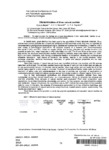Please use this identifier to cite or link to this item:
http://www.alice.cnptia.embrapa.br/alice/handle/doc/856610| Title: | Characterization of three natural zeolites. |
| Authors: | SOARES, F. S. C.  BERNARDI, A. C. de C.   NOGUEIRA, A. R. de A.   |
| Affiliation: | UFSCar-SAO CARLOS, SP; ALBERTO CARLOS DE CAMPOS BERNARDI, CPPSE; ANA RITA DE ARAUJO NOGUEIRA, CPPSE. |
| Date Issued: | 2010 |
| Citation: | In: INTERNATIONAL CONFERENCE ON FOOD AND AGRICULTURE APPLICATIONS OF NANOTECHNOLOGIES, 2010, São pedro, São Pedro: Aptor Software, 2010. |
| Pages: | p. 179 |
| Description: | In recent years, great attention has been paid to the application of nano structure materials. Since zeolites have primary particles with at least one dimension in the nanometer scale, they may be regarded as nanomaterials of geological and pedological origins. Zeolites are hydrated aluminosilicates, crystalline, with a wide variety of technological applications. Its structure consists of a skeleton with three-dimensional tetrahedral of AlO4 and SiO4, linked via oxygen atoms, and having channels and cavities in which it is possible to settle ions, water molecules or other adsorbates and salts. The Si and Al are at the center of the tetrahedron, the structural frame includes cavities occupied by relatively large sizes cations (Na+, K+, Ca2+, Mg2+) and water molecules, both having considerable freedom of movement, allowing ion exchange and reversible dehydration. High degree of hydration, low density, stability of the crystal structure, cation exchange properties, electrical conductivity, adsorption of gases and catalytic properties are the main properties of zeolites. About forty species of natural zeolites have been identified and over one hundred and fifty species have been synthesized. The synthetic zeolites have a high degree of purity and are widely used as catalysts for the petrochemical industry. In contrast, natural zeolites, have lower purity, and are easily found on the market, being used for a wide range of purposes. Treatment of industrial effluents, waste water purification, treatment of saline soils and supplementation in the diet of animals are examples of applications of commercial products made from natural zeolites derived from mines located in different regions of the world. Due to their technological applications and physicochemical properties, zeolites have been investigated owing their mineral identification and characterization. Aiming to obtaining the physical and chemical properties, three samples of natural zeolites were evaluated. Their main composition were respectively heulandites/clinoptilolite; clinoptilolite; and stilbite. For this purpose, we determined the particle size distribution, degree of hydration, the superficial area, by BET method, the assessment of the crystalline state by using micrography, the analysis of mineralogical composition by X-rays diffraction technique, and the chemical composition of natural zeolites by using inductively coupled plasma optical spectrometry. |
| Keywords: | Zeolita Fonte natural |
| Type of Material: | Resumo em anais e proceedings |
| Access: | openAccess |
| Appears in Collections: | Resumo em anais de congresso (CPPSE)  |
Files in This Item:
| File | Description | Size | Format | |
|---|---|---|---|---|
| PROCI2010.00009.pdf | 153,28 kB | Adobe PDF |  View/Open |









